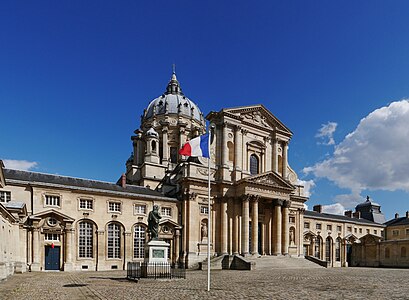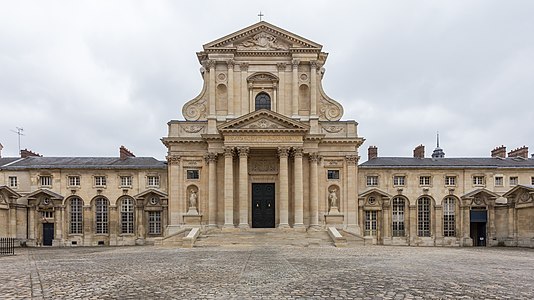Val-de-Grâce (church)
Coordinates: 48°50′27″N 02°20′31″E / 48.84083°N 2.34194°E


The Church of the Val-de-Grâce is a Roman Catholic church in the 5th arrondissement of Paris, in what is now the Val-de-Grâce Hospital. The edifice was formerly a royal abbey, and its dome is a principal landmark of the skyline of Paris. The church was initially designed by François Mansart, succeeded by Jacques Lemercier who designed the Saint-Sacrament chapel's spiral-coffered dome after Philibert de L'Orme's chapel at the Château d'Anet.[1]
History[]
The church was founded by Anne of Austria, Queen Consort of Louis XIII, in 1621. Anne, a devout Roman Catholic and counter-reformationist, had visited a priory in the deep valley of the Bièvre river and had become a friend of the prioress, Marguerite de Veny d'Arbouse. Anne suggested that an abbey be established with a suitable church. Construction began in 1634 on land given by the crown, the former Hôtel du Petit-Bourbon. Construction proceeded slowly, particularly after Anne fell from favor with the King. The estranged Anne spent time at the abbey, watched by Cardinal Richelieu and participating in intrigues with others who were out of favor. Louis finally forbade Anne to visit the abbey, but soon after, Anne became pregnant with Louis' heir, the Dauphin Louis Dieudonné.
After the death of her husband, Anne became Queen-Regent to her four-year-old son, now Louis XIV. In gratitude for her son, Anne pressed forward with the construction of an entirely rebuilt church and monastery, "to spare no expense and to leave an eternal mark of her piety." In 1645 Anne engaged François Mansart as the project's architect, but Mansart departed after only a year in disagreement over the scope and cost of the project. The church was finally finished in 1667, after the successive participation of Mansart, Jacques Lemercier, Pierre Le Muet and .
During the French Revolution the royal symbols were effaced. The abbey, still a model of religious construction of the 17th century, was disestablished during the French Revolution and became a military hospital in 1796 at the order of the National Convention. In 1979 the hospital was moved to a new facility, built on the former kitchen garden of the Benedictines. Today, the abbey contains the museum and library of the Army Health Service, the school of the Val-de-Grâce, and hospital staff offices.
When the abbey was disestablished in 1790 the furniture was removed along with the organ. The church itself was preserved as an architectural monument, and was spared the fate of several nearby convents, such as those of the Ursulines and the Feuillantines. The baldachino was preserved, but the high altar was moved to the care of the Petis-Augustins, and the small figures of the baldachino's nativity crèche were installed at the Church of Saint-Roch. The high altar was rebuilt at the order of Napoleon III by . The priest at Saint-Roch declined to return the original Anguier crèche, so a duplicate was created, using three sculptors: Clement Denis sculpted the infant Jesus, Justin-Marie the Virgin, and Joseph was sculpted by Louis Desprez.
Description of the church[]
The plan of the church is a Latin cross crowned by a dome. Mansart's plan envisioned towers flanking the nave and an elevated entrance, giving the impression of a castle rather than the façade of a traditional church.
The two-story facade, with its double stages of twin columns supporting a pediment and flanking consoles, recalls church elevations from the first part of the 17th century, such as the Église des Feuillants, also designed by Mansart in 1623-24. More clear and sober than the Mannerists, Mansart's facade squares his façade with linked vertical lines using the columns and entablatures. The dome, with Baroque accents, contains an inner dome decorated by Pierre Mignard (1663) and a baldachino inspired by that at Saint Peter's Basilica.
To give thanks for the birth of her son, Anne of Austria dedicated the church in honor of the Virgin Mary. The dedication on the porch pediment reads "IESU NASCENTI VIRGINIQ(UE) MATRI."
A copy of the Val-de-Grâce baldachino exists at the Church of Saint-François de Sales in Neuville, Quebec.
Cupola[]
The dome of Val-de-Grâce was painted by Pierre Mignard and completed in 1666.[2] Mignard was a praised and highly sought after painter, with a frequently cited rivalry between him and another famous painter of the era, Charles Le Brun. The painting was commissioned by Anne of Austria in 1663 and done in fresco, painting done on wet plaster. The style of painting, fresco, is more difficult than painting with oils, as was generally used for ceiling paintings in France, as it does not allow for second thoughts. Val-de-Grâce’s cupola was the first of its kind and magnitude in Paris, as only smaller painted cupolas existed then, including the one in Eglise des Carmes and the other in the chapel of the Sorbonne.[3] It was also the first important fresco in France, as all others were done with oil paint on canvas. After its completion, the dome was enhanced with oil pastels that faded soon after. Mignard’s superiority in this new art of fresco was celebrated in a poem written by Molière. The poem itself was intended partly to rebut claims about Le Brun’s genius made in a poem by Charles Perrault.[4]
The painting itself depicts Anne of Austria being presented by St Anne and St Louis. Anne of Austria presents a model of an abbey built at her request to the Holy Trinity: Father, Son, and Holy Ghost. The painting is a spiral composition with more than two hundred figures presented in concentric circles. Mignard uses foreshortening of figures, many different colors, and lighting effects in his painting.[3]
Organ[]
Nothing is known of the Val-de-Grâce pipe organ before the French Revolution, when it was dismantled and dispersed, apart from the name of its builder, Germain Pilon, who also built the organ at St. Louis des Invalides. The Val-de-Grâce had no organ until the late 19th century, when an Aristide Cavaillé-Coll organ which had been installed in 1853 in the church of Sainte Genevieve became available with the church's transformation into the Panthéon. The organ was moved to the Val-de-Grâce in 1891. The organ was lightly renovated and expanded in 1927 by Paul-Marie Koenig. The organ was restored in 1992-93, removing Koenig's additions, and the "petit grande-orgue" of Cavaillé-Coll is one of the few organs in the Paris region that has not been changed to suit the taste of the times.
Gallery[]
Crossing and dome from the southeast

Main facade and forecourt from the rue Saint-Jacques

Main facade with adjacent monastic buildings
Dome of the Saint-Sacrament chapel
See also[]
- Val-de-Grâce
- Category:Burials at Val-de-Grâce (church)
- History of early modern period domes
Notes[]
- ^ Ayers 2004, p. 114.
- ^ Nikolenko, Lada (2003). "Mignard family". Grove Art. doi:10.1093/gao/9781884446054.article.T057896. Retrieved 2019-04-29.
- ^ Jump up to: a b Mérot, Alain (1995). French Painting in the Seventeenth Century. Translated by Beamish. New Haven and London: Yale University Press. pp. 273–274. ISBN 0-300-06550-7.
- ^ Allen, Christopher (2003). French Painting in the Golden Age. United Kingdom: Thames & Hudson. pp. 175. ISBN 0-500-20370-9.
Bibliography[]
- Ayers, Andrew (2004). The Architecture of Paris. Stuttgart; London: Edition Axel Menges. ISBN 9783930698967.
External links[]
| Wikimedia Commons has media related to Église du Val-de-Grâce (Paris). |
- Roman Catholic churches completed in 1667
- Roman Catholic churches in the 5th arrondissement of Paris
- 1621 establishments in France
- Church buildings with domes
- 17th-century Roman Catholic church buildings in France




